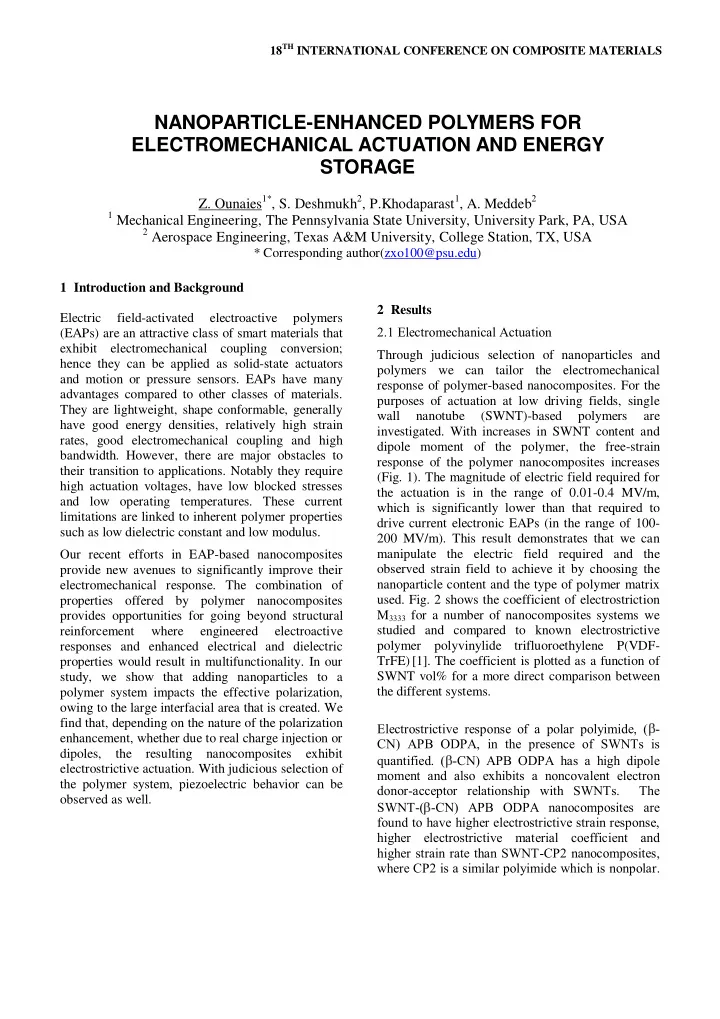

18 TH INTERNATIONAL CONFERENCE ON COMPOSITE MATERIALS NANOPARTICLE-ENHANCED POLYMERS FOR ELECTROMECHANICAL ACTUATION AND ENERGY STORAGE Z. Ounaies 1* , S. Deshmukh 2 , P.Khodaparast 1 , A. Meddeb 2 1 Mechanical Engineering, The Pennsylvania State University, University Park, PA, USA 2 Aerospace Engineering, Texas A&M University, College Station, TX, USA * Corresponding author(zxo100@psu.edu) Keywords :nanocomposites, capacitors, dielectric constant, electrostriction 1 Introduction and Background 2 Results Electric field-activated electroactive polymers 2.1 Electromechanical Actuation (EAPs) are an attractive class of smart materials that exhibit electromechanical coupling conversion; Through judicious selection of nanoparticles and hence they can be applied as solid-state actuators polymers we can tailor the electromechanical and motion or pressure sensors. EAPs have many response of polymer-based nanocomposites. For the advantages compared to other classes of materials. purposes of actuation at low driving fields, single They are lightweight, shape conformable, generally wall nanotube (SWNT)-based polymers are have good energy densities, relatively high strain investigated. With increases in SWNT content and rates, good electromechanical coupling and high dipole moment of the polymer, the free-strain bandwidth. However, there are major obstacles to response of the polymer nanocomposites increases their transition to applications. Notably they require (Fig. 1). The magnitude of electric field required for high actuation voltages, have low blocked stresses the actuation is in the range of 0.01-0.4 MV/m, and low operating temperatures. These current which is significantly lower than that required to limitations are linked to inherent polymer properties drive current electronic EAPs (in the range of 100- such as low dielectric constant and low modulus. 200 MV/m). This result demonstrates that we can manipulate the electric field required and the Our recent efforts in EAP-based nanocomposites observed strain field to achieve it by choosing the provide new avenues to significantly improve their electromechanical response. The combination of nanoparticle content and the type of polymer matrix used. Fig. 2 shows the coefficient of electrostriction properties offered by polymer nanocomposites provides opportunities for going beyond structural M 3333 for a number of nanocomposites systems we studied and compared to known electrostrictive reinforcement where engineered electroactive polymer polyvinylide trifluoroethylene P(VDF- responses and enhanced electrical and dielectric TrFE) [1]. The coefficient is plotted as a function of properties would result in multifunctionality. In our SWNT vol% for a more direct comparison between study, we show that adding nanoparticles to a the different systems. polymer system impacts the effective polarization, owing to the large interfacial area that is created. We find that, depending on the nature of the polarization Electrostrictive response of a polar polyimide, ( - enhancement, whether due to real charge injection or CN) APB ODPA, in the presence of SWNTs is dipoles, the resulting nanocomposites exhibit quantified. ( -CN) APB ODPA has a high dipole electrostrictive actuation. With judicious selection of moment and also exhibits a noncovalent electron the polymer system, piezoelectric behavior can be donor-acceptor relationship with SWNTs. The observed as well. SWNT-( -CN) APB ODPA nanocomposites are found to have higher electrostrictive strain response, higher electrostrictive material coefficient and higher strain rate than SWNT-CP2 nanocomposites, where CP2 is a similar polyimide which is nonpolar.
Thermally stimulated current measurements and (i) Low actuation electric fields, one to two orders dielectric relaxation experiments reveal a higher of magnitude lower than those needed for existing EAPs. polarization in the SWNT-( -CN) APB ODPA than (ii) Electrostrictive coefficients that are four to SWN-CP2 samples. This is attributed to the high seven orders of magnitude higher than those of dipole moment and SWNT-( -CN) APB ODPA known electroactive polymers. interaction. The effect of electric field frequency on (iii) Comparable gravimetric work densities to those the electromechanical response is also studied and is of known EAPs. found to decrease with frequency, consistent with a dipole-driven actuation. Despite these promising results, issues regarding The electromechanical coupling response can be dispersion of nanoparticles and high dielectric loss optimized by the choice of a polymer that displays a values remain. We address those by introducing in- high dipole moment and a strong interaction with the situ synthesis of nanoparticles in the polymer, and nanoparticles, such as through a noncovalent dipolar by exploring use of high dielectric, high aspect ratio interaction. The electromechanical strain response particles such as titania. Discussion of this study for our polyimide-based nanocomposite system follows. showed the following salient features: 0.0025 PVDF+0.4 vol%SWNT disk PVDF+0.67 vol%SWNT disk 0.0020 PVDF+1.33vol% SWNT disk PVDF+0.26 volt%SWNT film Strain S 33 0.0015 0.0010 0.0005 0.0000 0.0 0.1 0.2 0.3 0.4 0.5 0. E (MV/m) Fig. 1. Thickness strains for PVDF nanocomposites Figure 1. Thickness strains for PVDF nanocomposites Fig.2. Comparison of coefficient of electrostriction for a series of polymer-based nanocomposite systems 2.2 Dielectric Enhancement Although we have shown that the inclusion of (USA), respectively. TiO 2 anatase nano spheres (NS) SWNTs in polymers increases the dielectric (15nm diameter) and micro spheres (MS) (0.5 m properties and leads to electroactive strain at low diameter) are purchased from Nanostructured & electric field, presence of SWNTs also increases the Amorphous Materials, Inc and Sigma Aldrich, loss tangent and lowers the breakdown strength. In a respectively. Rutile TiO 2 particles have a relatively different approach, we investigate addition of TiO 2 high dielectric constant around 100 and anatase TiO 2 nanoparticles to PVDF to explore impact on particles have a dielectric constant around 70. The dielectric, loss and breakdown strength. solvent used in the composites is N,N- Polyvinylidene Fluoride (PVDF) Kynar 301 is dimethylacetamide (DMAc) which was purchased purchased from Arkema Inc. TiO 2 rutile nano rods from Sigma-Aldrich. The coupling agent is 3- (NR) (10x40nm) and nano wires (NW) aminopropyltriethoxysilane (APS) purchased from (130nmx1.68 m) are products of Nanostructured & Sigma-Aldrich. 2.3 and 4.6 vol% TiO 2 -PVDF Amorphous Materials, Inc and Ishihara Corporation composites were prepared. Two series of the
Recommend
More recommend